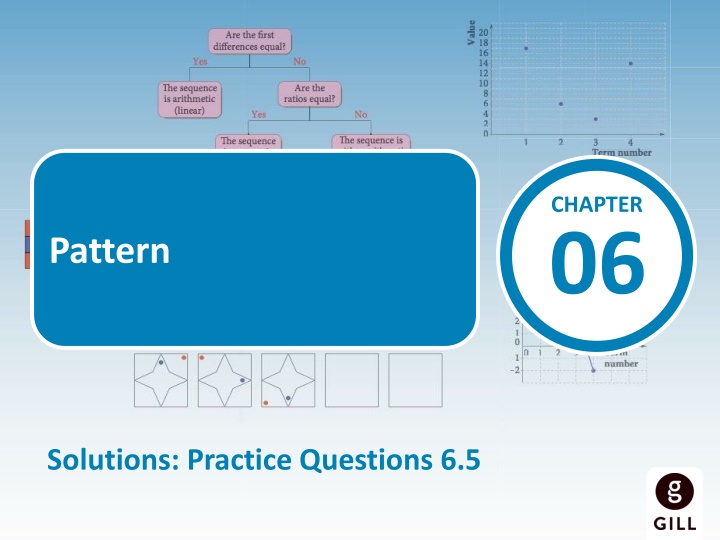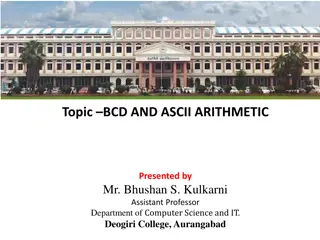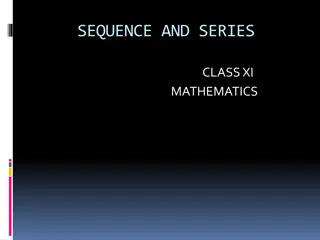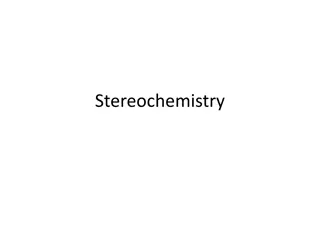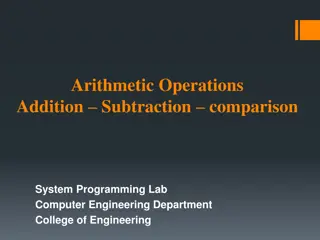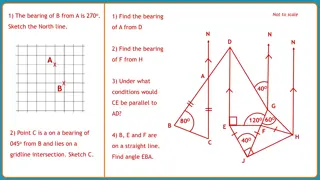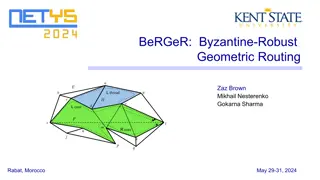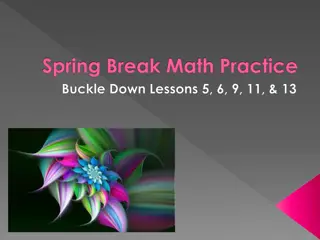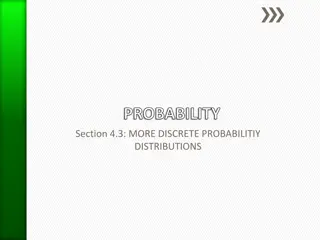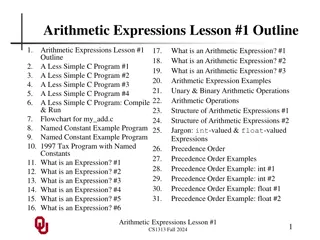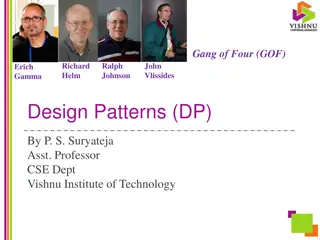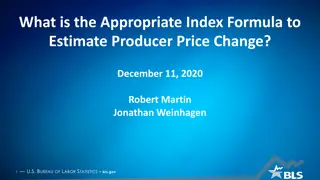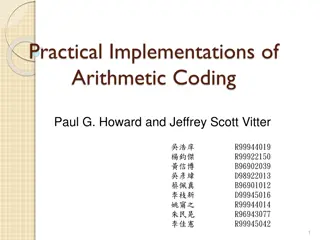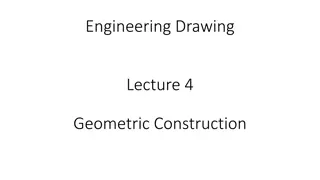Identify Arithmetic and Geometric Patterns
Practice questions to determine if provided number patterns are arithmetic, geometric, or neither. By analyzing first differences and ratios between consecutive terms, ascertain the nature of each pattern. Explore examples and explanations for a better understanding.
Download Presentation

Please find below an Image/Link to download the presentation.
The content on the website is provided AS IS for your information and personal use only. It may not be sold, licensed, or shared on other websites without obtaining consent from the author.If you encounter any issues during the download, it is possible that the publisher has removed the file from their server.
You are allowed to download the files provided on this website for personal or commercial use, subject to the condition that they are used lawfully. All files are the property of their respective owners.
The content on the website is provided AS IS for your information and personal use only. It may not be sold, licensed, or shared on other websites without obtaining consent from the author.
E N D
Presentation Transcript
CHAPTER 06 Pattern Solutions: Practice Questions 6.5
06 Practice Questions 6.5 1. Determine which of the following patterns are arithmetic, geometric or neither. Give reason for your answer. 3, 6, 12, 24, (i) Find the first differences: ? Find the ratio between consecutive terms: 6 3=2, 12 =2, 24 12=2 6 Since the ratios are equal, the pattern is geometric.
06 Practice Questions 6.5 1. Determine which of the following patterns are arithmetic, geometric or neither. Give reason for your answer. 2, 8, 18, 32, (ii) Find the first differences: ? Find the ratio between consecutive terms: 8 2=4, 18 =2 25, 32 18=1 7 8 Since neither the 1st difference nor ratios are equal, the pattern is neither arithmetic nor geometric.
06 Practice Questions 6.5 1. Determine which of the following patterns are arithmetic, geometric or neither. Give reason for your answer. 1 3 9, 3, 1, , (iii) Find the first differences: ? Find the ratio between consecutive terms: 1 3 1 3 9 1 3 1 3 1 3 = = , , Since the ratios are equal, the pattern is geometric.
06 Practice Questions 6.5 1. Determine which of the following patterns are arithmetic, geometric or neither. Give reason for your answer. 11, 7, 3, 1, (iv) Find the first differences: ? Since the 1st differences are equal, the pattern is arithmetic.
06 Practice Questions 6.5 1. Determine which of the following patterns are arithmetic, geometric or neither. Give reason for your answer. 1, 5, 25, 125, (v) Find the first differences: ? Find the ratio between consecutive terms: 5 1=5, 25 =5, 125 =5 5 25 Since the ratios are equal, the pattern is geometric.
06 Practice Questions 6.5 1. Determine which of the following patterns are arithmetic, geometric or neither. Give reason for your answer. 4, 3, 22, 59, (vi) Find the first differences: ? Find the ratio between consecutive terms: -4=-3 3 4, 22 =7 3 , 59 22=2 68 3 Since neither the 1st difference nor ratios are equal, the pattern is neither arithmetic nor geometric.
06 Practice Questions 6.5 1. Determine which of the following patterns are arithmetic, geometric or neither. Give reason for your answer. (vii) 3, 8, 2, 7, 1, Find the first differences: ? Find the ratio between consecutive terms: 8 3 2 8 1 4 7 2 1 7 1 7 = = = = 2 6, , 3 5, Since neither the 1st difference nor ratios are equal, the pattern is neither arithmetic nor geometric.
06 Practice Questions 6.5 1. Determine which of the following patterns are arithmetic, geometric or neither. Give reason for your answer. (viii) 9, 4, 1, 6, Find the first differences: ? Since the 1st differences are equal, the pattern is arithmetic.
06 Practice Questions 6.5 1. Determine which of the following patterns are arithmetic, geometric or neither. Give reason for your answer. 24, 12, 6, 3, (ix) Find the first differences: ? Find the ratio between consecutive terms: -12 24 2, -3 =-1 -12=-1 6 =-1 2, 6 2 Since the ratios are equal, the pattern is geometric.
06 Practice Questions 6.5 2. For each of the given graphs: (a) (i) List the first four terms of the sequence -1 3 4, 1 88 2, 0, ?
06 Practice Questions 6.5 2. For each of the given graphs: (a) (ii) Investigate whether the patterns are arithmetic or geometric. Find the first differences: ? ? 3 4 0= undefined, 1 88 Find the ratios: 0 =0, 0 75=2 5 -1 2 Since neither the 1st differences nor the ratios are equal, the pattern is neither arithmetic nor geometric.
06 Practice Questions 6.5 2. For each of the given graphs: (b) ? List the first four terms of the sequence. (i) 2, 0 75, 0 5, 1 75
06 Practice Questions 6.5 2. For each of the given graphs: (b) ? Investigate whether the patterns are arithmetic or geometric. (ii) Find the first differences: ? Since the 1st differences are equal, the pattern is arithmetic.
06 Practice Questions 6.5 3. The first three terms of a sequence are: 3p + q, 2p + 2q, p + 3q, where pand qare real numbers. Verify that this sequence is arithmetic. 3p + q, 2p + 2q, p + 3q T2 T1 = (2p + 2q) (3p + q) = 2p + 2q 3p q = 2p 3p + 2q q = p + q T3 T2 = (p + 3q) (2p + 2q) = p + 3q 2p 2q = p 2p + 3q 2q The 1st differences are equal, therefore the sequence is arithmetic. = p + q
06 Practice Questions 6.5 4. The first three terms of an arithmetic sequence are: k + 3, 5k 2, 6k 13, wherek is a real number. Find the value of k. (i) Since the sequence is arithmetic, the difference between any two consecutive terms are equal. k + 3, 5k 2, 6k 13 T2 T1 = (5k 2) (k + 3) T3 T2 = (6k 13) (5k 2) = 5k 2 k 3 = 6k 13 5k + 2 = 5k k 2 3 = 6k 5k 13 + 2 = 4k 5 = k 11
06 Practice Questions 6.5 4. The first three terms of an arithmetic sequence are: k + 3, 5k 2, 6k 13, wherek is a real number. Find the value of k. (i) Since the sequence is arithmetic, the difference between any two consecutive terms are equal. Let the differences equal: 4k 5 = k 11 4k k = 11 + 5 3k = 6 k = 2
06 Practice Questions 6.5 4. The first three terms of an arithmetic sequence are: k + 3, 5k 2, 6k 13, wherek is a real number. Hence, write down the value of the first three terms. (ii) k + 3 = 2 + 3 = 1 5k 2 = 5( 2) 2 = 10 2 = 12 6k 13 = 6( 2) 13 = 12 13 = 25
06 Practice Questions 6.5 4. The first three terms of an arithmetic sequence are: k + 3, 5k 2, 6k 13, wherek is a real number. Find the value of the eight term. (iii) Tn = a + (n 1)d a = 1, d = 13 T8 = 1 + (8 1)( 13) = 1 + (7)( 13) = 1 91 T8 = 90
06 Practice Questions 6.5 5. Three terms of a sequence are: 2x 3, 4x 6, 8x 12, wherex is a real number. Determine whether this sequence is arithmetic, geometric or neither. Find the first differences: T2 T1 = (8x 12) (4x 6) = 8x 12 4x + 6 = 8x 4x 12 + 6 = 4x 6 T3 T2 = (4x 6) (2x 3) = 4x 6 2x + 3 = 4x 2x 6 + 3 The 1st differences are not equal, therefore the pattern is not arithmetic. = 2x 3
06 Practice Questions 6.5 5. Three terms of a sequence are: 2x 3, 4x 6, 8x 12, wherex is a real number. Determine whether this sequence is arithmetic, geometric or neither. Find the ratio between two consecutive terms: =4x-6 2x-3=2(2x-3) T2 T1 =2 2x-3 =8x-12 4x-6 =2(4x-6) 4x-6 T3 T2 =2 The ratios are equal, therefore the pattern is geometric.
06 Practice Questions 6.5 6. Three terms of a sequence are: p q, 3p 2q, 6p 3q, where pandq are real numbers. Determine whether this sequence is arithmetic, geometric or neither. Find the first differences: T2 T1 = (3p 2q) (p q) = 3p 2q p+q = 3p p 2q +q = 2p q T3 T2 = (6p 3q) (3p 2q) = 6p 3q 3p + 2q = 6p 3p 3q + 2q The 1st differences are not equal, therefore the pattern is not arithmetic. = 3p q
06 Practice Questions 6.5 6. Three terms of a sequence are: p q, 3p 2q, 6p 3q, where pandq are real numbers. Determine whether this sequence is arithmetic, geometric or neither. Find the ratio between two consecutive terms: =3p-2q p-q T2 T1 cannot be simplified =6p-3q 3p-2q=3(2p-q) T3 T2 cannot be simplified 3p-2q The ratios are not equal, therefore the pattern is not geometric. Therefore, the pattern is neither arithmetic nor geometric.
06 Practice Questions 6.5 7. Three terms of a sequence are: (2a + b 5c), (3a 4c) and (4a b 3c), where a, b and care real numbers. Determine whether this sequence is arithmetic, geometric or neither. Find the first differences: T2 T1 = (3a 4c) (2a + b 5c) = 3a 4c 2a b + 5c = 3a 2a b 4c + 5c = a b + c T3 T2 = (4a b 3c) (3a 4c) = 4a b 3c 3a + 4c The first differences are equal, therefore the pattern is arithmetic. = 4a 3a b 3c + 4c = a b + c
